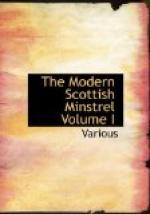Buchanan’s life was short. He was cut off by typhus fever, at a period when his talents had begun to attract a more than local attention. It was within a year after his return from superintending the press of the first version of the Gaelic New Testament, that his lamented death took place. His command of his native tongue is understood to have been serviceable to the translator, the Rev. James Stewart of Killin, who had probably been Buchanan’s early acquaintance, as they were natives of the same district. This reverend gentleman is said to have entertained a scheme of getting the catechist regularly licensed to preach the gospel without the usual academical preparation. The scheme was frustrated by his death, in the summer of 1768.
We know of no fact relating to the development of the poetic vein of this interesting bard, unless it be found in the circumstance to which he refers in his “Diary,"[104] of having been bred a violent Jacobite, and having lived many years under the excitement of strong, even vindictive feelings, at the fate of his chief and landlord (Buchanan of Arnprior and Strathyre), who, with many of his dependents, and some of the poet’s relations, suffered death for their share in the last rebellion. While he relates that the power of religion at length quenched this effervescence of his emotions, it may be supposed that ardent Jacobitism, with its common accompaniment of melody, may have fostered an imagination which every circumstance proves to have been sufficiently susceptible. It may be added, as a particular not unworthy of memorial in a poet’s life, that his remains are deposited in perhaps the most picturesque place of sepulture in the kingdom—the peninsula of Little Leny, in the neighbourhood of Callander; to which his relatives transferred his body, as the sepulchre of many chiefs and considerable persons of his clan, and where it is perhaps matter of surprise that his Highland countrymen have never thought of honouring his memory with some kind of monument.
The poetic remains of Dougal Buchanan do not afford extensive materials for translation. The subjects with which he deals are too solemn, and their treatment too surcharged with scriptural imagery, to be available for the purposes of a popular collection, of which the object is not directly religious. The only exception that occurs, perhaps, is his poem on “The Skull.” Even in this case some moral pictures[105] have been omitted, as either too coarsely or too solemnly touched, to be fit for our purpose. A few lines of the conclusion are also omitted, as being mere amplifications of Scripture—wonderful, indeed, in point of vernacular beauty or sublimity, but not fusible for other use. Slight traces of imitation may be perceived; “The Grave” of Blair, and some passages of “Hamlet,” being the apparent models.
[102] “Statistical Account of Fortingall.”—Stat. Acc., x., p. 549.
[103] The same account observes that though none of his works are published but his sacred compositions, he composed “several songs on various subjects.”




